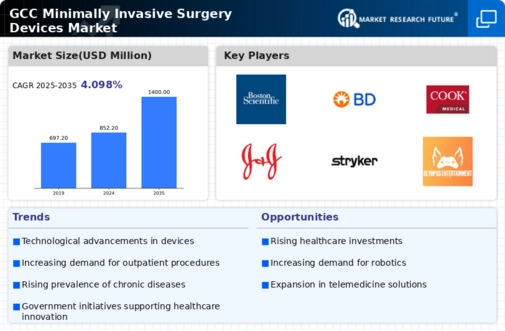Surge in Healthcare Expenditure
Healthcare expenditure in the GCC countries has been on an upward trajectory, which is likely to bolster the minimally invasive-surgery-devices market. Governments are increasingly investing in healthcare infrastructure, with budgets allocated for advanced medical technologies. For instance, the healthcare spending in the UAE is projected to reach approximately $20 billion by 2025. This financial commitment facilitates the acquisition of state-of-the-art surgical devices, enhancing the capabilities of healthcare facilities. As hospitals and clinics upgrade their equipment to meet modern standards, the demand for minimally invasive surgical devices is expected to rise, reflecting a broader trend towards improved patient care and operational efficiency.
Supportive Regulatory Environment
The regulatory environment in the GCC is becoming increasingly supportive of the minimally invasive-surgery-devices market. Regulatory bodies are streamlining approval processes for new medical devices, which encourages innovation and market entry. This supportive framework is essential for manufacturers looking to introduce advanced surgical technologies. Additionally, initiatives aimed at improving healthcare standards and patient safety are fostering a conducive environment for the growth of minimally invasive surgical solutions. As regulations evolve to accommodate new technologies, the market is likely to benefit from increased investment and development, ultimately enhancing the availability of minimally invasive surgical devices across the region.
Growing Awareness of Surgical Options
There is a notable increase in patient awareness regarding surgical options, which is influencing the minimally invasive-surgery-devices market. Patients are becoming more informed about the benefits of minimally invasive procedures, such as shorter recovery times and reduced pain. This awareness is often driven by educational campaigns and the proliferation of information through digital platforms. As patients actively seek out these options, healthcare providers are compelled to offer minimally invasive solutions to meet this demand. Consequently, the market is likely to experience growth as more individuals opt for these advanced surgical techniques, thereby enhancing overall patient satisfaction and outcomes.
Increasing Prevalence of Chronic Diseases
The rising incidence of chronic diseases in the GCC region is a pivotal driver for the minimally invasive-surgery-devices market. Conditions such as cardiovascular diseases, diabetes, and obesity are becoming more prevalent, necessitating advanced surgical interventions. According to health statistics, the prevalence of diabetes in the GCC is estimated to be around 20%, significantly higher than the global average. This trend compels healthcare providers to adopt minimally invasive techniques, which are associated with reduced recovery times and lower complication rates. As the population ages and lifestyle-related health issues escalate, the demand for innovative surgical solutions is likely to grow, thereby propelling the minimally invasive-surgery-devices market forward.
Technological Innovations in Surgical Devices
Technological innovations are transforming the landscape of the minimally invasive-surgery-devices market. Advancements in robotics, imaging technologies, and surgical instruments are enhancing the precision and effectiveness of minimally invasive procedures. For example, the introduction of robotic-assisted surgery has revolutionized surgical practices, allowing for greater dexterity and control. The GCC region is witnessing a surge in the adoption of these technologies, with hospitals investing in cutting-edge equipment to improve surgical outcomes. As these innovations continue to evolve, they are likely to drive the growth of the minimally invasive-surgery-devices market, as healthcare providers seek to leverage the latest advancements to enhance patient care.

















Leave a Comment